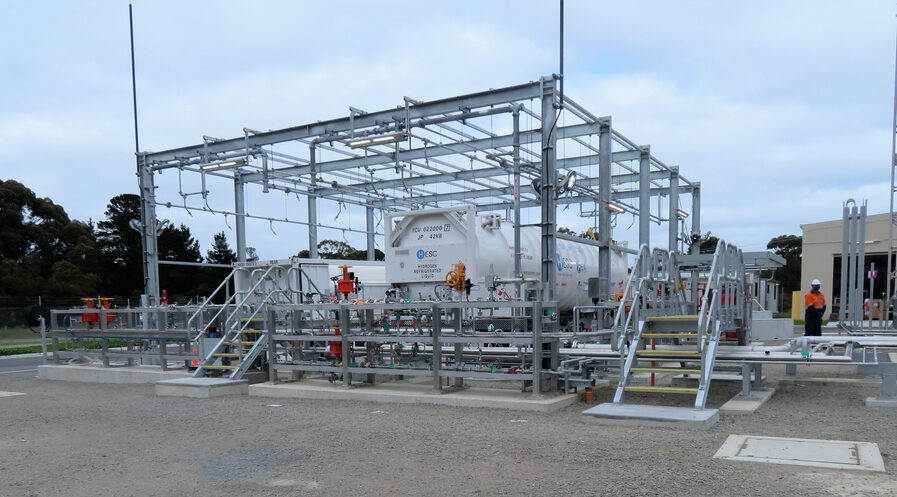
The Hydrogen Energy Supply Chain (HESC) Project plant in Hastings, Victoria, Australia. Currently ,the plant ships to Japan. Hydrogen energy production was identified by the Australian government as one of the new technologies to reduce carbon emissions.
Australia’s lowering carbon emissions with new technology
Carbon emissions come with drastic consequences. Climate change, which has aggravated and increased incidences of natural catastrophes such as droughts, bushfires, and tsunamis, among others, is largely a result of unchecked global warming, brought about by the overproduction of greenhouse gases, specifically carbon dioxide (CO2).
Australia’s expenditures
Energy consumption is by far the largest source of human-caused greenhouse gas emissions, responsible for producing 73% of greenhouse gases worldwide. Within the energy sector, the generation of heat and electricity is responsible for most emissions.
After major oil-producing countries, Australia is one of the world’s largest carbon emitters on a per capita basis, producing 17 tonnes of CO2 emissions yearly. To put that into perspective, the global average stood at 4.8 tonnes in 2017.
In 2015, Australia’s energy sector made up 79% of emissions. Of this, electricity made up 35%. However, direct combustion from factories and transportation contributed 18% each.

From (Department of Environment and Energy, 2016). Direct combustion includes emissions from burning coal and gas for industrial and building
heat, steam, and pressure as well as emissions from combustion of fuel for mobile equipment in mining, manufacturing, construction, agriculture, forestry, and fishing. Fugitive emissions include GHG released during coal mining, and oil and gas production and transport. The split of electricity between buildings and industry is approximated from electricity consumption of commercial and residential as a percentage of total thermal electricity in 2014-15 from 2016 Australian Energy Statistics (Office of the Chief Economist, Table F). Split for direct combustion calculated from (Australian Government Department of the Environment and Energy, 2016)
Govt’s initiatives to lower carbon emissions
Most of the world has, by now, enacted some forms of legislation to rein in their carbon footprint expenditure, especially viz their Paris Agreement commitments. On 10 November 2016, Australia ratified the Paris Agreement, committing to achieving a 26-28% reduction in greenhouse gas (GHG) emissions below 2005 levels by 2030.
The Paris Agreement also requires signatories to strengthen their abatement efforts over time with the overarching goal of limiting the increase in global average temperature to well below 2°C above pre-industrial levels, with efforts to limit the temperature increase to 1.5°C.
In 2020, the government announced a total funding package of A$1.6 billion (US$1.2 billion) for the Australian Renewable Energy Agency (Implementing the Technology Roadmap) Regulations 2021 including guaranteed baseline funding of A$1.43 billion (US$1.1 billion) over the next 10 years.
ARENA was given A$192.5 million (US$141.8 million) this year to deliver programs. These include supporting microgrids in regional Australia, reducing barriers to the use of electric vehicles or vehicles powered by biofuels or clean hydrogen, and investigating energy efficiency and emissions reduction in energy-intensive industries, according to a statement by ARENA.
In July this year, the Australian government launched new rules aimed at supporting the next generation of low emission energy technologies (LETs).
Under the new rules, ARENA will be able to support priority technologies identified in the first Low Emissions Technology Statement, including green hydrogen, energy storage, low emission aluminum and steel, carbon capture and storage (CCS), and soil carbon.
Addressing challenges
According to the government, Australia’s natural renewable energy and mineral resources, vast landmass, suitable geology, and close proximity to emerging markets will continue to be the foundation of their low emissions efforts.
However, a key challenge revolves around supplying affordable, renewable energy, as well as the transformation of energy-intensive industries.
Affordable, clean, and reliable energy is the cornerstone of improved productivity, competitiveness, and lower emissions from industries. Lower energy costs will reduce pressure on household budgets and improve quality of life.
Low-cost and reliable energy will encourage more onshore energy-intensive manufacturing, and improved productivity and reduced emissions intensity will help capture new opportunities in a global low emissions economy.
Reducing carbon emissions with new technologies
Priority low emissions technologies (LETs) are those expected to have a significant impact on Australia’s big technological challenges and opportunities. These technologies have the highest abatement and economic potential in areas of comparative advantage for Australia.
They are priorities where government investments can make a difference in reducing prices and improving technology readiness.
The Roadmap identified five priority new and emerging technologies:
- Clean hydrogen;
- Long duration energy storage;
- Low carbon materials, including aluminum and steel;
- Carbon capture and storage; and
- New measurement technologies for healthier soils
These priority low emissions technologies will offer emissions reduction opportunities across Australia’s economic sectors, with sequestration technologies also providing additional decarbonization pathways for key industries, while protecting and preserving jobs.
Economic stretch goals are ambitious but realistic goals to bring priority low emissions technologies to economic parity with existing mature technologies. Stretch goals have been set for each priority technology.
The Australian government will target international partnerships that support these economic stretch goals, including access to global markets and more competitive supply chains. They will also prioritize partnerships that focus on critical research, development, and deployment challenges for economically important, hard-to-abate sectors.
READ MORE
- The criticality of endpoint management in cybersecurity and operations
- Ethical AI: The renewed importance of safeguarding data and customer privacy in Generative AI applications
- How Japan balances AI-driven opportunities with cybersecurity needs
- Deploying SASE: Benchmarking your approach
- Insurance everywhere all at once: the digital transformation of the APAC insurance industry




